How to quickly learn the multiplication table?

The fact that twice two is four is clear to everyone, at least this is how it is sung in a well-known children's song. But what if your child does not want to remember this in any way? There are ways to learn the multiplication table quickly and in a fun way, so let's talk about them in more detail.
How to understand the meaning of multiplication?
First of all, you need to explain to the child the meaning of multiplication. It has been proven that when a person understands what he has to remember, he masters the subject quickly, with greater speed than when he simply memorizes letters and even more so numbers. And the conscious information stays in the head much longer than the one that is mechanically memorized. There is evidence that meaningful information is memorized four times more efficiently than that which is recorded on the disk of our brain as a kind of plate. She just sooner or later (rather, the first) will deteriorate.
So, before demanding that the multiplication table bounces off the teeth of a child, explain to him its meaning, why he might need it in life. And only then start your studies.
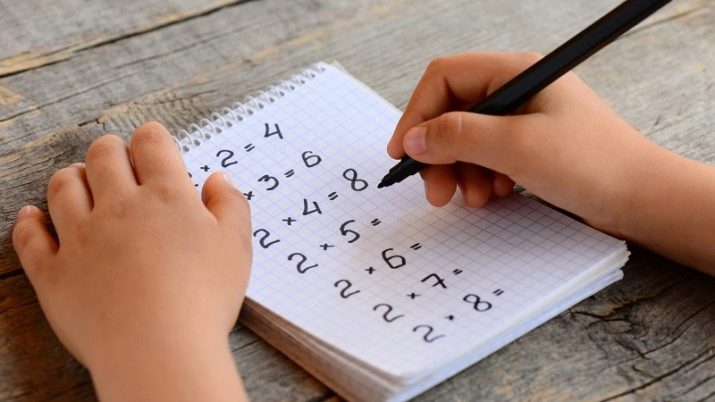
Patterns of the table
One way that is used to make the multiplication table learn easily is mastering its laws... Open them to the child as a kind of secret. Let him feel better like a magician than a great mathematician. This way, learning the multiplication table is not only easier, but also more interesting.
So, let's dive into the magic of numbers. For example, tell us that no matter what number is multiplied by five, the result is a number with a zero or five at the end. But it's better to start with one.... At first glance, a completely useless exercise, but the child will quickly remember that in fact nothing needs to be done, since one does not change anything in another digit when multiplying.
Thus, he will also be able to understand the basics of multiplication faster. Next, we move on to more complex examples. We ourselves know about the magic of multiplying by nine. Take the multiplication table. Study it carefully. You will notice that in the column where the numbers from one to ten are multiplied by nine, the products have the following pattern: the first digits of the result start from zero and end with a nine, the second are arranged in the same order, only not from top to bottom, but vice versa.
Agree, mesmerizing. And now, your child is already wondering what will happen next.
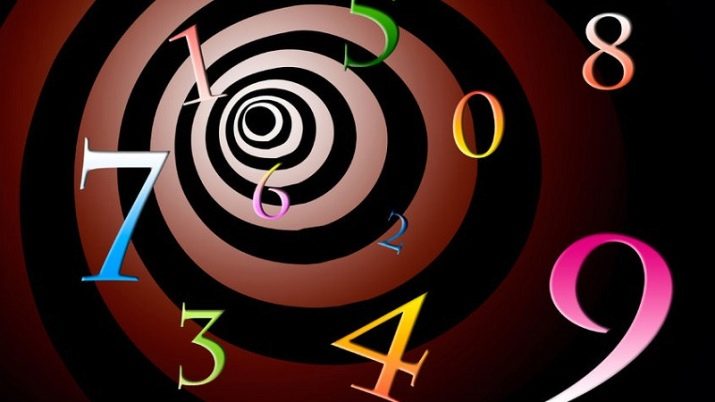
Learning rules
First, choose the method that's right for your child. If he is a born humanist and poetry is much easier for him than solving problems in mathematics, use simple quatrains about the multiplication table. Examples are given below. If your child is more of a physicist than a lyricist, use counting sticks, for example. But in both cases, a number of rules must be followed.
Classes
Lessons should not tire the child. As soon as you notice that he begins to lose interest, immediately end the lesson. Do not overload the head of the little man, otherwise you will only cause aversion to any kind of exercise. Don't ask your child to make an instant decision. Sooner or later he will be able to multiply two by two - he just needs time. In no case do not scold the child, even if he does not succeed.
But for every, even small, achievement, be sure to praise. No, you don't have to run to the store and buy an expensive toy as a prize for the lesson you have learned - just tell him that he is great. Although a small present will not be superfluous either.
Change
They should be. Even if it seems to you that the child himself does not want to stop, slow down the process... Remember how you did the school? “We wrote, we wrote, our fingers are tired. We will rest a little and start writing again. " This will help relieve stress, both mental and physical.
And you yourself will be able to gain patience during the rest. We don't get annoyed when our little one doesn't succeed, right?
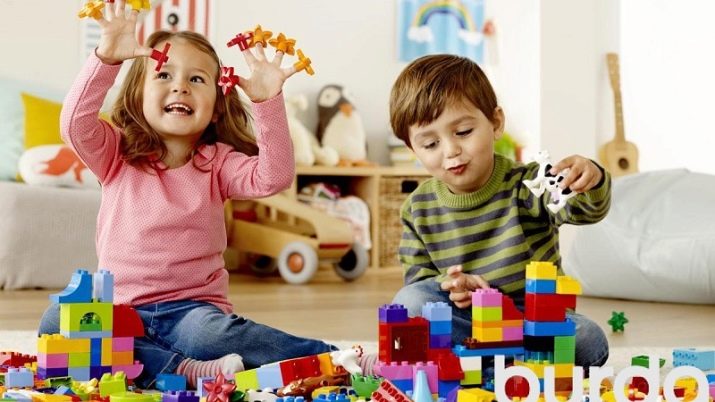
Memorization methods
It is a good idea if you coordinate with your child's teacher and use the same or similar methods. But nowadays, parents often begin to develop their offspring long before he enters elementary school. This is perhaps a good thing. But just do not deprive the baby of his childhood. In this case, the game is your best way to comprehend math..
Scatter Lego blocks around the room. Surely there will be enough details in it to study the entire multiplication table and even more. Divide the parts into equal piles, where their number is a multiplier, and the number of piles themselves is a multiplier.
We begin to solve the problem by collecting parts into a certain structure. Your task is not to create a beautiful shape, but to explain how the multiplication takes place. Further it is easier - there are three parts in two piles, there are only six of them. Thus, we multiply 3 by 2. The main thing is to remember that in 5 minutes you will not learn the multiplication table, even with a child prodigy.
But the more non-standard methods you use, the more chances for success. Come up with interesting tasks. Take out all the toy cars your child has from the box. Have you already guessed how to explain that two times two is four? Just leave the all-terrain vehicle with eight wheels aside for the duration of this activity, and it is better to save the tractor with six as well. They will be useful to us in the next lessons.
Mathematics is an exact science, so use absolutely appropriate subjects to explain it. Toys don't fit - try another trick. Make signs with an example on one side and a solution on the other.And start this card game for numbers. Do not stop "pestering" the child during walks. Come up with an unconventional approach to learning multiplication tables.

For example, we saw a dog in the yard - we count how many paws, ears, eyes it has. And how much will it be if another neighbor comes out with his pet? Multiply the number of dogs by the number of their paws and vice versa. The more unusual the methods, the more interesting it is for the child. Use again the "tricks" of some numbers. Has your child forgotten about multiplying by 9? Please clarify this. Does your child love computer games? This is a real life hack for you. Download the online multiplication table trainer to your phone or tablet.
There are other unconventional ways as well. Does your daughter love to cook with you? Count how many eggs you need if you make three fried eggs for five days in a row. If your child is a young shopaholic, the following technique will work for you: Returning from the bakery, count how many loaves of bread you will buy if you go to the store every day all week. Let it all be necessary to multiply 7 by 1. The main thing is that in this case you are explaining the multiplication process.
If you don't have enough imagination, consult a specialist or special literature. Here is a list of just some of the magic books to help you.
- "How I taught my girl the multiplication table." Author Tatyana Shklyarova will tell you how to master the basics of mathematics with your child during the summer holidays.
- "We quickly learn the multiplication table." This teaching aid was created by Elena Nefedova and Olga Uzorova. Their own proprietary program will help improve your knowledge of mathematics in general.
- "A quick and easy way to learn the multiplication table." The author Yana Pligina became popular among parents, as she not only developed a unique technique, but also detailed the rules of exciting games on a mathematical topic.
Also, her book is equipped with a "magic bookmark", which arouses even more interest in her.
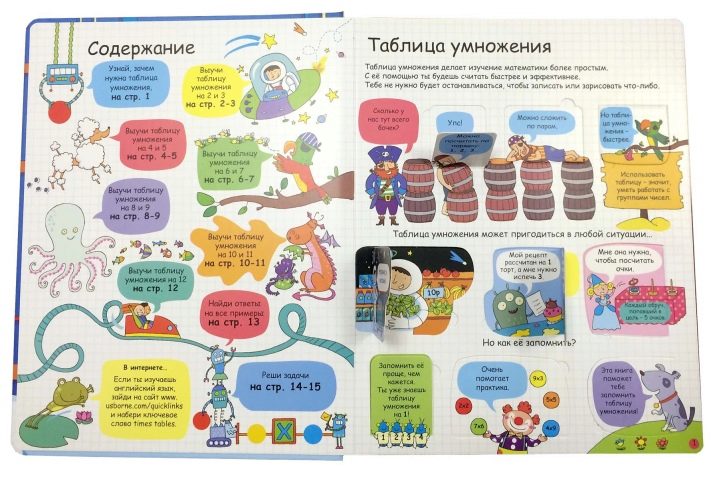
Base
And yet, do not forget about the old and proven methods. Make signs, where on the left side write examples in a column, leave the right one free. It must be filled in by a child. Therefore, try to make large cells.
Use bright colored pencils or markers. Get the kid interested. Do not try to "shove" the multiplication table into the head of your son or daughter all at once. Start gradually. Even each number can be divided into several activities. And do not forget about breaks: 10-15 minutes of math, and then - outdoor games or a lunch break.
Poetry
This method is very common, but it does not always lead to the fact that the child understands how numbers, and not words, add up into a single whole. Therefore, it is recommended to use it only as an auxiliary. In addition to the already mentioned songs about twice two - four, use others that are not so famous, but no less memorable from this.
- Multiplying three by one, we find ourselves on a page from the book of fairy tales for children about three funny pigs.
- Let's multiply three by six in two, the most likely to become a great hunt. You know, the years go by quickly. And now you are already eighteen.
- And how many will be three times eight? We will deal with the question in a day. Indeed, in a day, as is known in the world, there are only twenty four hours.
In addition to quatrains once invented by someone else, you can use your own. Add verses from numbers. It's fun. But our task is not to bore the child even with the most serious question.
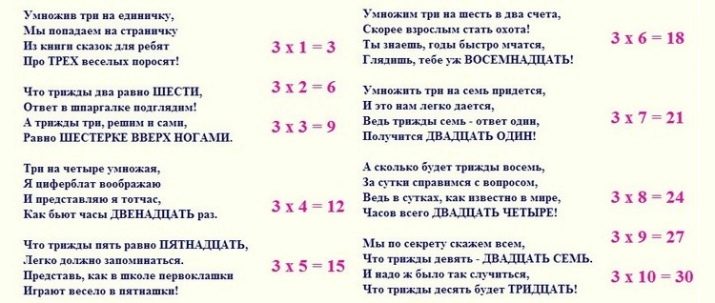
Games
Educational games are now available in most children's stores. There are also multiplication tables special for studying. Perhaps, instead of the twenty-eighth typewriter, it is better to buy one. Just pay attention to the design and color of the toy. She has to attract the child. And of course, don't forget about safety. Ask the sellers for a certificate for the product.
Fingers
Many of us in adulthood use finger counting to add up some numbers.But you can multiply with your hands. And this is another "magic" trick that will help keep your child interested and make math entertaining.
Circle the child's arms. Now number each finger from left to right. And now we start multiplying by the same magic nine. Select the digit to be multiplied. We can count the answer on our fingers. To the left of the multiplied number, the number of tens will remain, to the right - units. Well, isn't it magic?
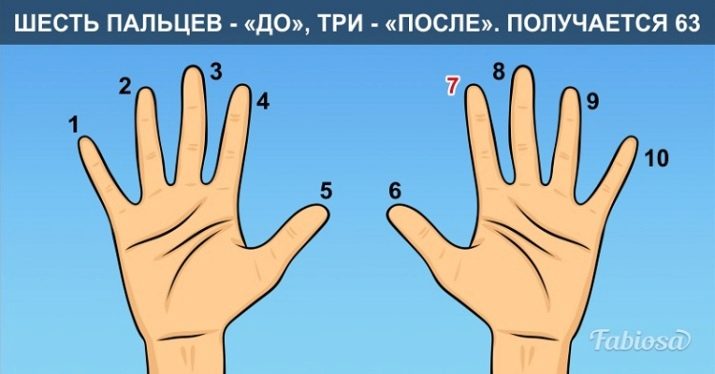
Tips for Parents
Don't demand more from your child than he is capable of. The kid is not ready to learn the multiplication table at the age of four - leave him alone. Will have time yet. Otherwise, you risk instilling guilt and an inferiority complex in your baby. And he is unlikely to run to school with joy.
To begin with, try using real life examples - toys and animals will attract much more child's attention than the multiplication table itself. By the way, it can be hung a little later in the child's room. He, without noticing it, will draw information from it. You can also print the exercises. Sooner or later, anyone, even the most mischievous boy, will be interested in what this fascinated you with in the computer and now lies on the table in paper form.
Although modern kids are mostly interested in what flashes on the screen. So let this be a special application for learning the multiplication table. And for starters, a calculator can be used as a toy, not a machine for counting money.
Imagine, this will not only add craving for knowledge to your baby, but also make you a more versatile adult.









